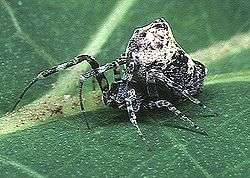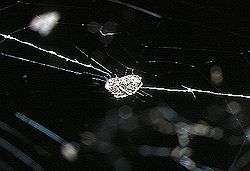Philoponella
| Philoponella | |
|---|---|
 | |
| female P. prominens from Okinawa | |
| Scientific classification | |
| Kingdom: | Animalia |
| Phylum: | Arthropoda |
| Subphylum: | Chelicerata |
| Class: | Arachnida |
| Order: | Araneae |
| Infraorder: | Araneomorphae |
| Family: | Uloboridae |
| Genus: | Philoponella Mello-Leitão, 1917 |
| Species | |
|
See text. | |
| Diversity | |
| 37 species | |
Philoponella is a genus of uloborid spiders. Like all Uloboridae, these species have no venom.
Cooperation
Some species (among them P. congregabilis and P. oweni) construct communal webs, but nevertheless do not capture prey cooperatively. However, a few species, such as P. raffrayi, are known to cooperate in prey capture. A colony of P. raffrayi is composed of individual orb-webs connected by non-adhesive silk. Its average body length is about 6 mm in females and 3 mm in males. Adult females are orange for at least a week after the final molt, and become black a few weeks later. In these colonies, Argyrodes and Portia species can also be found, acting as kleptoparasites and predators, respectively. When relatively large prey is trapped on the periphery of the colony, two females cooperate in about 10% of cases in wrapping it, which increases their chances of success about fourfold. However, only one female then feeds on this prey. Cooperative capture is similar in P. republicana, where more than two individuals may work together.[1]
Philoponella vicina uses its silk to compress and crush its prey.[2]
Distribution
Philoponella species occur pantropical in the Americas, Africa, southeastern Asia and Australia, with almost half of them found from the southern United States to northern Argentina.
Species


- Philoponella angolensis (Lessert, 1933) — Ivory Coast, Angola
- Philoponella arizonica (Gertsch, 1936) — USA, Mexico
- Philoponella bella Opell, 1979 — Colombia
- Philoponella collina (Keyserling, 1883) — Peru
- Philoponella congregabilis (Rainbow, 1916) — New South Wales
- Philoponella cymbiformis Xie et al., 1997 — China
- Philoponella divisa Opell, 1979 — Colombia
- Philoponella fasciata (Mello-Leitão, 1917) — Brazil, Paraguay, Argentina
- Philoponella gibberosa (Kulczynski, 1908) — Java
- Philoponella herediae Opell, 1987 — Costa Rica
- Philoponella hilaris (Simon, 1906) — India
- Philoponella lingulata Dong, Zhu & Yoshida, 2005 — China
- Philoponella lunaris (C. L. Koch, 1839) — Brazil
- Philoponella mollis (Thorell, 1895) — Myanmar
- Philoponella nasuta (Thorell, 1895) — China, Myanmar
- Philoponella nigromaculata Yoshida, 1992 — Taiwan
- Philoponella operosa (Simon, 1896) — South Africa
- Philoponella oweni (Chamberlin, 1924) — USA, Mexico
- Philoponella pantherina (Keyserling, 1890) — New South Wales
- Philoponella para Opell, 1979 — Paraguay, Argentina
- Philoponella pisiformis Dong, Zhu & Yoshida, 2005 — China
- Philoponella pomelita Grismado, 2004 — Argentina
- Philoponella prominens (Bösenberg & Strand, 1906) — China, Korea, Japan
- Philoponella quadrituberculata (Thorell, 1892) — Java, Moluccas
- Philoponella raffrayi (Simon, 1891) — Java, Moluccas
- Philoponella ramirezi Grismado, 2004 — Brazil
- Philoponella republicana (Simon, 1891) — Panama to Bolivia
- Philoponella sabah Yoshida, 1992 — Borneo
- Philoponella semiplumosa (Simon, 1893) — USA, Greater Antilles to Venezuela
- Philoponella signatella (Roewer, 1951) — Mexico to Honduras
- Philoponella subvittata Opell, 1981 — Guyana
- Philoponella tingens (Chamberlin & Ivie, 1936) — Costa Rica to Colombia
- Philoponella truncata (Thorell, 1895) — Myanmar, Java
- Philoponella variabilis (Keyserling, 1887) — Queensland, New South Wales
- Philoponella vicina (O. P.-Cambridge, 1899) — Mexico to Costa Rica
- Philoponella vittata (Keyserling, 1881) — Panama to Paraguay
- Philoponella wuyiensis Xie et al., 1997 — China
Footnotes
- ↑ Matsumoto 1998
- ↑ Eberhard, William G.; Barrantes, Gilbert & Weng, Ju-Lin (2006). "Tie them up tight: wrapping by Philoponella vicina spiders breaks, compresses and sometimes kills their prey". Naturwissenschaften 95(5): 251-254. doi:10.1007/s00114-006-0094-1 — HTML abstract
References
- Tamerlan Thorell (1895). Descriptive catalogue of the spiders of Burma
- Opell, B.D. (1987). "The new species Philoponella herediae and its modified orb-web (Araneae, Uloboridae)". J. Arachnol. 15: 59-63. PDF
- Matsumoto, Toshiya (1998). "Cooperative prey capture in the communal web spider, Philoponella raffray (Araneae, Uloboridae)". Journal of Arachnology 26: 392-396. PDF
- Grismado, Christian J. (2004). "Two new species of the genus Philoponella from Brazil and Argentina (Araneae, Uloboridae)". Iheringia, Sér. Zool. 94(1): 105-109. PDF
- Platnick, Norman I. (2008). The world spider catalog, version 8.5. American Museum of Natural History.
| Wikimedia Commons has media related to Philoponella. |